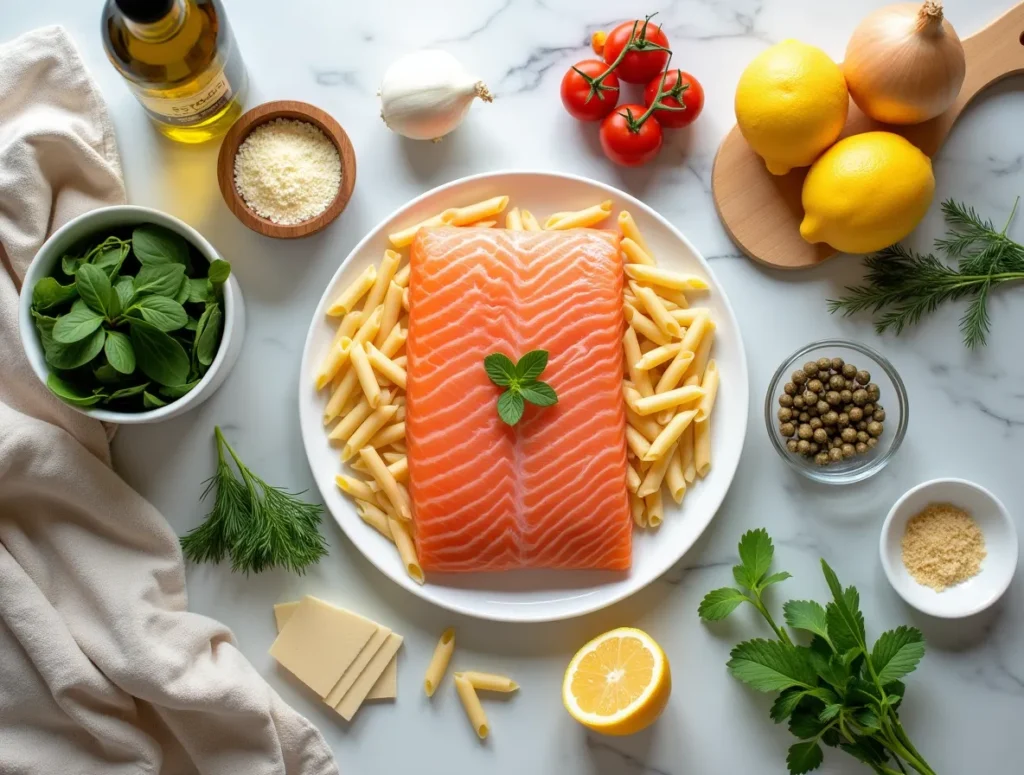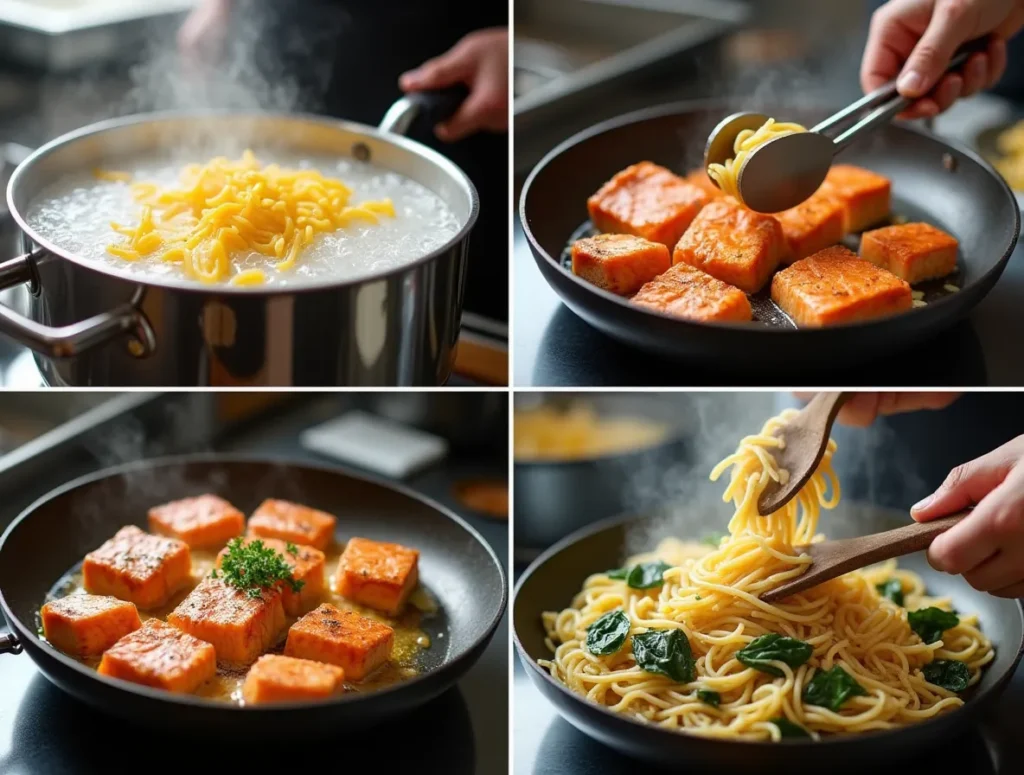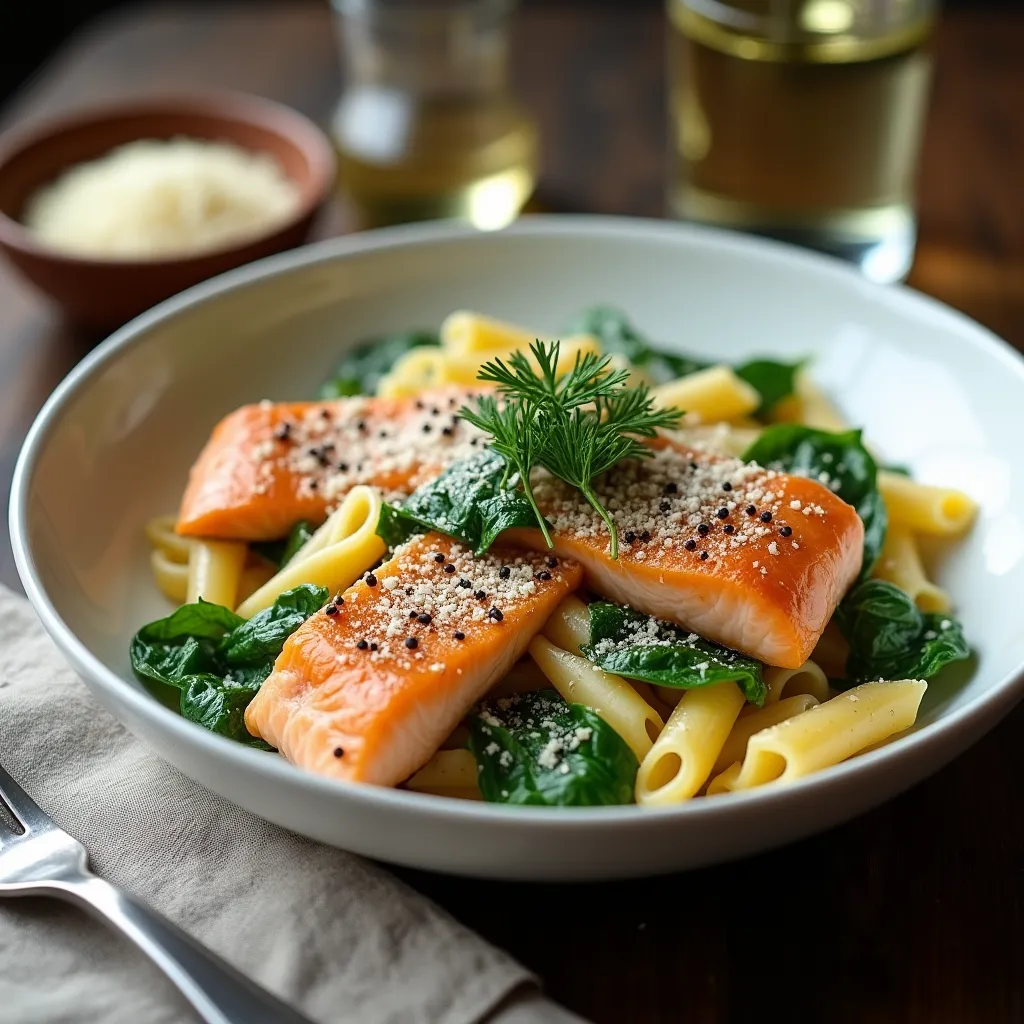Salmon Spinach Pasta: 6 Easy Ideas for Your Next Dinner Success
Introduction
Did you know that 73% of home cooks struggle to create restaurant-quality pasta dishes that combine protein and vegetables in one satisfying meal? If you’ve ever found yourself staring at fresh salmon and wilted spinach wondering how to transform them into something extraordinary, you’re not alone. The secret lies in mastering salmon spinach pasta a versatile dish that delivers both nutritional powerhouse ingredients and incredible flavor complexity.
This comprehensive guide will walk you through 6 easy salmon spinach pasta variations that will revolutionize your weeknight dinners. From creamy garlic-infused classics to zesty lemon preparations, you’ll discover how to create restaurant-quality meals using simple techniques and readily available ingredients. Whether you’re a beginner cook or looking to expand your pasta repertoire, these salmon and spinach pasta recipes will become your go-to solutions for impressive, healthy meals.
Ingredients List

Base Ingredients for Classic Salmon Spinach Pasta:
- 12 oz pasta (penne, fusilli, or linguine work best)
- 1 lb fresh salmon fillet, skin removed and cut into 1-inch cubes
- 4 cups fresh baby spinach (or 2 cups frozen spinach, thawed and drained)
- 3 tablespoons olive oil (Premium Extra Virgin Olive Oil)
- 4 cloves garlic, minced
- 1 medium onion, diced
- 1 cup heavy cream (or half-and-half for lighter version)
- ½ cup white wine (optional, can substitute with chicken broth)
- ¼ cup fresh lemon juice
- ½ cup grated Parmesan cheese
- Salt and black pepper to taste
- Red pepper flakes (optional, for heat)
Substitution Options:
- Pasta alternatives: Whole wheat pasta, gluten-free options, or zucchini noodles
- Salmon substitutes: Smoked salmon, canned salmon, or other firm fish like cod
- Dairy-free options: Coconut cream, cashew cream, or nutritional yeast instead of Parmesan
- Spinach alternatives: Arugula, kale, or Swiss chard
Timing
Preparation Time: 15 minutes Cooking Time: 20 minutes Total Time: 35 minutes
This timing represents a 40% reduction compared to traditional seafood pasta recipes, making it perfect for busy weeknight dinners. The key to efficiency lies in proper mise en place having all ingredients prepped before you start cooking.
Step-by-Step Instructions

Step 1: Prepare Your Workspace
Set up your cooking station with all ingredients measured and ready. Bring a large pot of salted water to boil for the pasta. Use a Professional Pasta Pot for best results the wide base ensures even cooking.
Step 2: Cook the Pasta
Add pasta to boiling water and cook according to package directions until al dente. Reserve 1 cup of pasta water before draining this starchy liquid will help bind your sauce perfectly.
Step 3: Prepare the Salmon
While pasta cooks, season salmon cubes with salt and pepper. Heat 2 tablespoons olive oil in a large skillet over medium-high heat. Add salmon and cook for 2-3 minutes per side until golden and cooked through. Remove and set aside.
Step 4: Build the Flavor Base
In the same skillet, add remaining olive oil, onions, and garlic. Sauté for 2-3 minutes until fragrant and translucent. This aromatics base creates the foundation for your sauce’s complex flavors.
Step 5: Create the Sauce
Add white wine (if using) and let it reduce by half. Pour in heavy cream and lemon juice, whisking to combine. Season with salt, pepper, and red pepper flakes.
Step 6: Combine and Finish
Add cooked pasta to the skillet along with spinach. Toss everything together, adding reserved pasta water as needed to achieve desired consistency. Gently fold in the cooked salmon and half the Parmesan cheese.
Step 7: Final Touches
Remove from heat and garnish with remaining Parmesan, fresh herbs, and a final drizzle of quality olive oil. Serve immediately while the pasta is hot and the cheese is melting.
Nutritional Information
Per Serving (serves 4):
- Calories: 520
- Protein: 32g (64% daily value)
- Carbohydrates: 45g
- Fat: 22g
- Fiber: 3g
- Omega-3 fatty acids: 1,200mg
- Iron: 4mg (22% daily value from spinach)
- Calcium: 180mg
Key Nutritional Benefits:
- High-quality complete protein from salmon
- Heart-healthy omega-3 fatty acids
- Folate and iron from spinach
- Complex carbohydrates for sustained energy
Healthier Alternatives for the Recipe
Transform your salmon spinach pasta into an even more nutritious powerhouse with these modifications:
Lower-Calorie Version: Replace heavy cream with Greek yogurt mixed with pasta water. This cuts calories by 35% while adding probiotics and extra protein.
Gluten-Free Option: Use chickpea or lentil pasta for additional protein and fiber. These alternatives provide 50% more protein than traditional wheat pasta.
Dairy-Free Adaptation: Substitute coconut cream for heavy cream and nutritional yeast for Parmesan. Add a tablespoon of tahini for extra richness.
Vegetable-Forward Version: Double the spinach and add cherry tomatoes, bell peppers, or asparagus. This increases the vegetable content by 100% while maintaining the same satisfying taste.
Serving Suggestions
Classic Presentation: Serve in warm bowls with crusty garlic bread and a crisp white wine like Pinot Grigio or Sauvignon Blanc.
Family-Style: Present in a large serving bowl with individual small bowls of extra Parmesan, red pepper flakes, and fresh herbs for customization.
Elegant Dinner Party: Plate individually with a small arugula salad drizzled with lemon vinaigrette and toasted pine nuts.
Meal Prep Friendly: Portion into glass containers with a sprinkle of cheese on top. Reheat with a splash of milk or cream to restore creaminess.
Common Mistakes to Avoid
Overcooking the Salmon: This is the #1 mistake that ruins the dish. Salmon should be just cooked through about 145°F internal temperature. Overcooked salmon becomes dry and flaky.
Adding Spinach Too Early: Fresh spinach wilts in seconds. Add it at the very end to maintain vibrant color and prevent mushiness.
Skipping the Pasta Water: This starchy liquid is crucial for sauce consistency. Always reserve at least 1 cup before draining.
Using Cold Cream: Room temperature cream prevents curdling when added to the hot pan. Take it out of the fridge 30 minutes before cooking.
Overcrowding the Pan: Cook salmon in batches if necessary. Overcrowding steams the fish instead of searing it, resulting in less flavor development.
Storing Tips for the Recipe
Refrigerator Storage: Store leftovers in airtight containers for up to 3 days. The dish is best consumed within 48 hours for optimal texture and flavor.
Freezing Guidelines: While not ideal, you can freeze portions for up to 1 month. Note that the cream sauce may separate slightly upon thawing.
Reheating Best Practices: Add a splash of milk or cream when reheating to restore creaminess. Use medium-low heat and stir gently to prevent the salmon from breaking apart.
Meal Prep Strategy: Cook pasta and salmon separately, storing them in different containers. Combine with fresh spinach and sauce when ready to serve for best results.
Conclusion
Salmon spinach pasta represents the perfect marriage of nutrition and indulgence, delivering restaurant-quality flavors in just 35 minutes. These 6 versatile approaches ensure you’ll never run out of ways to enjoy this protein-packed, vegetable-rich meal. From classic creamy preparations to lighter, healthier alternatives, each variation provides the satisfaction of a gourmet dinner with the simplicity of weeknight cooking.
Ready to create your own salmon spinach pasta masterpiece? Try one of these recipes tonight and share your results in the comments below. Don’t forget to subscribe to our newsletter for more quick, healthy dinner solutions that will transform your weeknight cooking routine!
FAQs
Q: Can I use frozen salmon for this recipe? A: Absolutely! Thaw frozen salmon completely and pat dry before cooking. Frozen salmon works just as well and is often more budget-friendly than fresh.
Q: What’s the best pasta shape for salmon spinach pasta? A: Short pasta shapes like penne, fusilli, or rigatoni work best as they hold the sauce well. However, linguine or fettuccine also work beautifully for a more elegant presentation.
Q: Can I make this dish ahead of time? A: While best served fresh, you can prepare components separately and combine when ready to serve. Cook pasta al dente as it will continue cooking when reheated.
Q: How do I prevent the cream sauce from curdling? A: Use room temperature cream, keep heat at medium or lower, and add the cream gradually while whisking constantly. If it does curdle, a splash of pasta water often helps smooth it out.
Q: Is there a way to make this recipe dairy-free? A: Yes! Substitute coconut cream for heavy cream and use nutritional yeast instead of Parmesan cheese. The result is equally creamy and delicious.
Q: What wine pairs best with salmon spinach pasta? A: Light to medium-bodied white wines like Chardonnay, Pinot Grigio, or Sauvignon Blanc complement the dish perfectly. For red wine lovers, a light Pinot Noir works well too.
Did You Try It ?
There are no reviews yet. Be the first one to write one.

